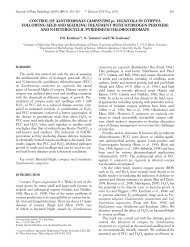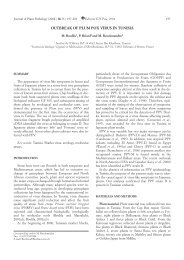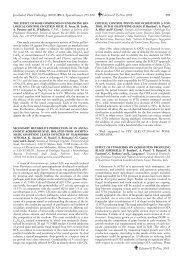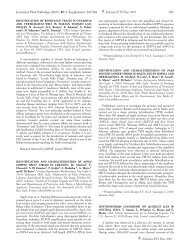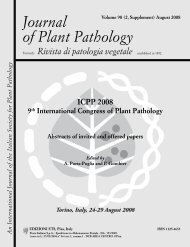Journal of Plant Pathology (2010), 92 (4, Supplement ... - Sipav.org
Journal of Plant Pathology (2010), 92 (4, Supplement ... - Sipav.org
Journal of Plant Pathology (2010), 92 (4, Supplement ... - Sipav.org
You also want an ePaper? Increase the reach of your titles
YUMPU automatically turns print PDFs into web optimized ePapers that Google loves.
<strong>Journal</strong> <strong>of</strong> <strong>Plant</strong> <strong>Pathology</strong> (<strong>2010</strong>), <strong>92</strong> (4, <strong>Supplement</strong>), S4.71-S4.105 S4.99<br />
However lesions were produced only by isolate, R82 since no<br />
fungal growth was observed on malt extract agar plates amended<br />
with TBZ (400 mg/g) and inoculated with small pieces <strong>of</strong> rotted<br />
tissues. To explain the mode <strong>of</strong> action <strong>of</strong> isolate R82, a double<br />
Petri-dish assay was performed. Antifungal activity was probably<br />
due to the production <strong>of</strong> volatile substances whose identification<br />
through Gas Mass technique is in progress. In conclusion, diffusible<br />
substances generated by Penicillium R82 isolate and present<br />
in culture filtrate showed activity against the above listed<br />
postharvest pathogens. A possible application <strong>of</strong> these natural<br />
substances could be the postharvest bi<strong>of</strong>umigation <strong>of</strong> fruit in<br />
storage room, to prevent losses through the distribution chain.<br />
THE ROLE OF PLANT GENOTYPE IN THE BENEFI-<br />
CIAL INTERACTION BETWEEN TOMATO AND THE<br />
BCAS TRICHODERMA spp. M. Ruocco 1 , M. Tucci 2 , L. De<br />
Masi 2 , M. de Palma 2 , S. L. Woo 3 , F. Vinale 3 , S. Lanzuise 3 , M.<br />
Nigro, A.M. El-Tabey Eid 3 , M. Lorito 3,1 . 1 Istituto di Protezione<br />
delle Piante del CNR, Via Università 133, 80055 Portici (NA),<br />
Italy. 2 Istituto di Genetica Vegetale del CNR, Via Università 133,<br />
80055 Portici (NA), Italy. 3 Dipartimento di Arboricoltura, Botanica<br />
e Patologia Vegetale, Università degli Studi di Napoli “Federico II”,<br />
Via Università 100, 80055 Portici (NA), Italy. E.mail: ruocco@<br />
ipp.cnr.it<br />
Selected fungi <strong>of</strong> the genus Trichoderma have the ability to interact<br />
simultaneously with plants and pathogens. These antagonists<br />
can trigger systemic and localised resistance to diseases and<br />
promote plant growth and development. Additional effects include<br />
the suppression <strong>of</strong> deleterious soil micr<strong>of</strong>lora/fauna, degradation<br />
<strong>of</strong> toxic compounds, direct stimulation <strong>of</strong> root development,<br />
by producing hormone-like compounds or affecting plant<br />
synthetic pathways, and/or promotion <strong>of</strong> water and nutrient uptake.<br />
However, the occurrence <strong>of</strong> the above benefits depends on<br />
the specific plant genotype, although this concept has been poorly<br />
investigated. In this work we have studied the effects <strong>of</strong> two<br />
Trichoderma species (T. harzianum T22 and T. atroviride P1) on<br />
several cultivated and wild tomato genotypes (Solanum lycopersicum<br />
and S. habrochaites) in terms <strong>of</strong> promotion <strong>of</strong> seed germination<br />
and plant development, protection against pathogens and<br />
transcriptional modifications <strong>of</strong> response genes. Strong differences<br />
in the response to the symbiotic interaction with the two<br />
Trichoderma strains were found among different tomato varieties.<br />
In fact, the effect <strong>of</strong> T. harzianum T22 and T. atroviride P1 on the<br />
growth and systemic resistance against B. cinerea depended<br />
strongly on the genotype tested. Our data on the induction <strong>of</strong> defence<br />
response pathways may help the selection or breeding <strong>of</strong><br />
tomato lines with enhanced ability to benefit from the interaction<br />
with Trichoderma, which may support a correct application <strong>of</strong> Trichoderma-based<br />
bio-pesticides and bio-fertilizers in agriculture.<br />
ACTIVITY OF ELECTROLYZED OXIDIZING WATER<br />
GENERATED BY DIAMOND THIN FILM ELECTRODES<br />
IN REDUCING PATHOGENIC MICROBIAL POPULA-<br />
TION IN PACKINGHOUSE WASH WATER. S.M. Sanzani 1 ,<br />
F. Fallanaj 1 , C. Zavanella 2 , A. Ippolito 1 . 1 Dipartimento di Protezione<br />
delle Piante e Microbiologia Applicata, Università degli<br />
Studi “Aldo Moro”, Via Amendola 165/A, 70126 Bari, Italy.<br />
2 Adamant Technologies SA Eplatures-Grise 17, 2300 La Chaux-de-<br />
Fonds, Switzerland. E-mail: simona.sanzani@agr.uniba.it<br />
Electrolyzed Oxidizing Water (EOW), generated by electrolysis<br />
<strong>of</strong> a salt solution, recently gained attention for its possible use<br />
as eco-friendly alternative method for the inactivation <strong>of</strong> the<br />
pathogenic micr<strong>of</strong>lora <strong>of</strong> fresh fruit and vegetables. Aim <strong>of</strong> the<br />
present investigation was to determine if EOW generated by Diamond<br />
Thin Film Electrodes has potential for use in commercial<br />
packinghouses to control the main pathogens <strong>of</strong> harvested fruits.<br />
EOW was generated with Diacell, an electrolytic cell based on<br />
boron-doped diamond electrodes (Adamant Technologies SA,<br />
CH) that are known for their outstanding electrochemical properties,<br />
including the production <strong>of</strong> a wide range <strong>of</strong> oxidising<br />
species. Spores <strong>of</strong> Penicillium expansum were suspended in EOW<br />
produced either in the presence or absence <strong>of</strong> 1 g/l <strong>of</strong> NaCl to increase<br />
conductivity. Furthermore, the suspension itself was subjected<br />
to direct electrolysation. Fungal growth was assessed after<br />
24-48 h incubation at room temperature. When NaCl was used,<br />
EOW exhibited nearly 100% inhibition <strong>of</strong> P. expansum spore<br />
germination, whereas in the absence <strong>of</strong> NaCl a significant although<br />
lower efficacy (around 60% reduction) was recorded.<br />
The efficacy <strong>of</strong> disinfection increased to 98% after 75 min <strong>of</strong> direct<br />
electrolysis. On the basis <strong>of</strong> the results obtained a further trial<br />
was conducted on the wash water from a local packinghouse,<br />
which was subjected to electrolysis in presence <strong>of</strong> NaCl for 3 h. A<br />
visible improvement <strong>of</strong> water clearness and a significant reduction<br />
<strong>of</strong> total microbial population was obtained after only 30 min<br />
treatment. Trials on sweet cherries treated with EOW in commercial<br />
packinghouses are in progress.<br />
PROFILING OF SMALL RNAs POPULATIONS DERIVED<br />
FROM SOUR ORANGE SEEDLINGS SHOWING CROSS-<br />
PROTECTION AGAINST SEEDLING YELLOWS<br />
STRAINS OF CITRUS TRISTEZA VIRUS. M. Saponari 1,4 , H.<br />
Doddapaneni 2 , G. Loconsole 3 , A. Giampetruzzi 3 , P. Saldarelli 1 ,<br />
R.K. Yokomi 4 . 1 Istituto di Virologia Vegetale del CNR, Via Amendola<br />
165/A, 70126 Bari, Italy. 2 Carver Center for Genomics, Department<br />
<strong>of</strong> Biology, University <strong>of</strong> Iowa, 52242 Iowa City, IA,<br />
USA. 3 Dipartimento di Protezione delle Piante e Microbiologia Applicata,<br />
Università degli Studi “Aldo Moro”, Via Amendola 165/A,<br />
70126 Bari, Italy. 4 USDA, Agricultural Research Service, 93648<br />
Parlier, CA, USA. E-mail: m.saponari@ba.ivv.cnr.it<br />
Cross protection against the stem pitting strain <strong>of</strong> Citrus tristeza<br />
virus (CTV) has been used to reduce losses to grapefruit and<br />
sweet orange. Recent studies have shown that cross-protection<br />
occurs between isolates <strong>of</strong> the same genotype, but its mechanism<br />
is unknown. Recently, endogenous small (s) RNAs were shown to<br />
play a role in plant stress response. During viral infections they<br />
originate either from the viral or plant genomes. High-throughput<br />
sequencing to assess sRNA pr<strong>of</strong>ile is a powerful new technology<br />
for discovery <strong>of</strong> new approaches for disease control by understanding<br />
plant/virus interactions at the sRNA level. This technology<br />
was used to examine seedling yellows cross protection <strong>of</strong><br />
CTV. Small RNAs fractions from a symptomless sour orange<br />
seedling (SO) infected with a mixture <strong>of</strong> T3, VT and non-standard<br />
CTV genotypes (S2) vs. SO infected with the VT component<br />
which resulted in severe seedling yellows (S1) were sequenced<br />
by Illumina Genome Analyzer II. The 21-24 nucleotide<br />
size classes dominated both libraries. Among the virus-derived<br />
sRNAs those from the 3’end genomic region, which includes the<br />
three gene silencing suppressors were predominant in both libraries,<br />
but with significant difference in the accumulation <strong>of</strong> one<br />
or the other suppressor. The largest class <strong>of</strong> the host-derived sR-<br />
NAs localized in the CTV resistance gene locus; specifically they<br />
derived from the Gipsy-like retrotransposone C. More comparative<br />
bioinformatics analyses are underway to correlate sRNA pr<strong>of</strong>iles<br />
with the phenotypes for a better understanding <strong>of</strong> the CTV<br />
and host genes involvement and regulation.



